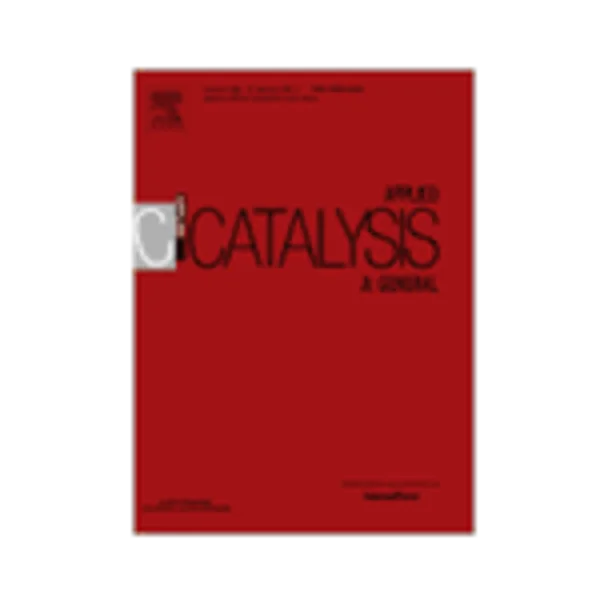-
preparation, characterization and use of v2o5-tio2 mixed xerogels as catalysts for sustainable oxidation with hydrogen peroxide of 2,3,6-trimethylphenol
جزئیات بیشتر مقاله- تاریخ ارائه: 1392/07/24
- تاریخ انتشار در تی پی بین: 1392/07/24
- تعداد بازدید: 946
- تعداد پرسش و پاسخ ها: 0
- شماره تماس دبیرخانه رویداد: -
v2o5-tio2 mixed xerogels were prepared with different loads of tio2 and v2o5 (5%, 10%, 15% v2o5 w/w) by the sol–gel method using titanium isopropoxide and vanadyl acetylacetonate as precursors. the solids obtained were characterized by xrd, ft-ir and sem. their textural properties were determined by adsorption–desorption isotherms of n2 at 77 k. also the acidity of the catalysts was measured by means of potentiometric titration with a solution of n-butylamine in acetonitrile. the catalysts were tested in the liquid phase oxidation of 2,3,6-trimethylphenol (2,3,6-tmf) to 2,3,5-trimethyl-p-benzoquinone (2,3,5-tmbq) at 20 °c, using ethanol as solvent and aqueous hydrogen peroxide as clean oxidizing agent. the conversion increases with time to reach at 3 h a plateau of 93% and 88% for the samples without v and with 5% of v respectively. an increase of the v concentration to 10% leads to a conversion value of only 22% at 4 h of reaction. however, the selectivity to 2,3,5-tmbq increases with the v content in the catalyst. the stability and leaching of catalysts and the influence of the xerogel calcination temperature were also studied. by reusing the same catalyst sample with 5% of v, a difference of 5% in the selectivity values between use and reuse was observed. a decrease from 88% to 8% of 2,3,6-tmp conversion for 4 h of reaction, when the calcination temperature of xerogel increased from 200 °c to 400 °c, was observed. when t-butanol was added as radical scavenger, the oxidation was strongly suppressed. this makes it possible to propose a radical mechanism for 2,3,6-trimethylphenol oxidation. substrates with different substitutes in phenol were also tested in the oxidation reaction. the substrates with methyl groups are the most actives and in the cases of thymol and carvacrol with isopropyl groups, the conversion is lower.
مقالات جدیدترین رویدادها
-
استفاده از تحلیل اهمیت-عملکرد در ارائه الگوی مدیریت خلاقیت سازمانی و ارائه راهکار جهت بهبود
-
بررسی تاثیر ارزش وجوه نقد مازاد بر ساختار سرمایه شرکت های پذیرفته شده در بورس اوراق بهادار تهران
-
بررسی تأثیر سطح افشای ریسک بر قرارداد بدهی شرکت های پذیرفته شده در بورس اوراق بهادار تهران
-
بررسی تأثیر رتبه بندی اعتباری مبتنی بر مدل امتیاز بازار نوظهور بر نقد شوندگی سهام با تأکید بر خصوصی سازی شرکت ها
-
تأثیر آمیخته بازاریابی پوشاک ایرانی بر تصویر ذهنی مشتری پوشاک ایرانی (هاکوپیان)
-
بررسی رفتار ساختمان های بتن آرمه بهسازی شده با دیوارهای برشی آلومینیومی
-
ارزیابی درجه تراکم دانه بندی گسسته و پیوسته سنگدانه ها در حالت دو بعدی
-
بررسی طراحی بهینه و عملکرد لرزه ای میراگرهای ویسکوز الحاقی در نواحی زلزله خیز
-
طرح دعاوی خصوصی از نظر ضمان قهری و ضررو زیان وارد در دادگاه های عمومی
-
بررسی نحوه طراحی و رتبه بندی سایت در سامانه leed و breeam و امکان سنجی آن با مقررات ملی ساختمان در ایران
مقالات جدیدترین ژورنال ها
-
مدیریت و بررسی افسردگی دانش آموزان دختر مقطع متوسطه دوم در دروان کرونا در شهرستان دزفول
-
مدیریت و بررسی خرد سیاسی در اندیشه ی فردوسی در ادب ایران
-
واکاوی و مدیریت توصیفی قلمدان(جاکلیدی)ضریح در موزه آستان قدس رضوی
-
بررسی تاثیر خلاقیت، دانش و انگیزه کارکنان بر پیشنهادات نوآورانه کارکنان ( مورد مطالعه: هتل های 3 و 4 ستاره استان کرمان)
-
بررسی تاثیر کیفیت سیستم های اطلاعاتی بر تصمیم گیری موفق در شرکتهای تولیدی استان اصفهان (مورد مطالعه: مدیران شرکتهای تولیدی استان اصفهان)
-
نقش صله رحم در سلامت جسمی و روحی خانواده با تمرکز بر گزاره های اسلامی
-
بررسی تاثیر یارانه سفر بر توسعه گردشگری؛ مطالعه موردی: گردشگران شهر مشهد مقدس
-
evaluate the use of recycled asphalt pavement (rap) in the construction of roller compacted concret pavement (rcc)
-
the transformation of aesthetics in architecture from traditional to modern architecture: a case study of the yoruba (southwestern) region of nigeria
-
exploring in silico drug design and pharmacokinetics study for identification of potent antidepressant agents




سوال خود را در مورد این مقاله مطرح نمایید :